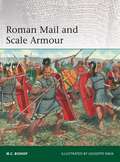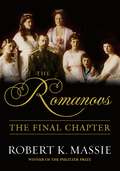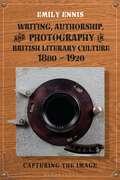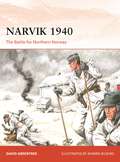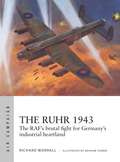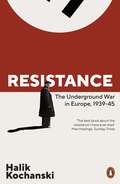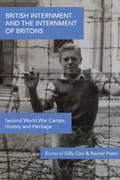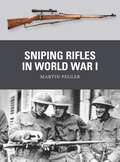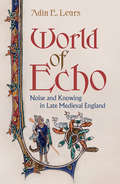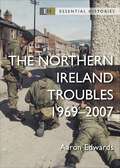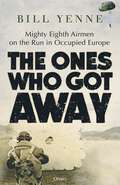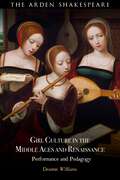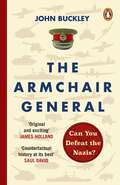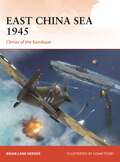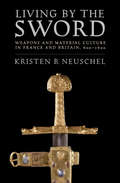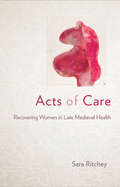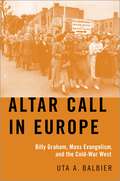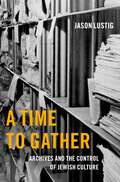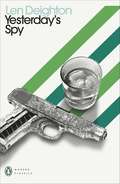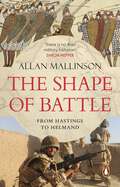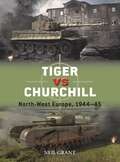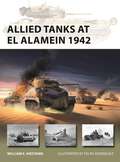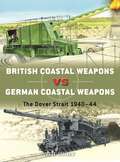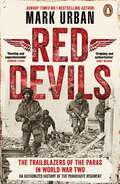- Table View
- List View
Roman Mail and Scale Armour (Elite #252)
by M.C. BishopFully illustrated, this study investigates the origins, evolution and use of the mail and scale armour worn by the soldiers and gladiators of Imperial Rome.Less glamorous than the Roman Army's instantly recognizable plate armour but much more versatile, mail and scale armour were used by both legionaries and auxiliaries throughout Rome's history. Developed by the Celts and quickly adopted by the Romans, mail armour was easy to make and required little maintenance. Scale was a much older form of armour, originating in the Near East during the second millennium BC. As with mail, it was used by both auxiliaries and legionaries, but like plate armour, it was much more fragile than mail. Both types of armour were also used by gladiators (principally as arm defences).New discoveries in both mail and scale, as well as in hybrid forms that mixed the two, mean that much more is now known about the development of these types of defence during the Roman period, their efficacy in battle and how they were manufactured and repaired. Featuring specially commissioned artwork and drawing upon the latest findings, this study lifts the veil on the mail and scale armour used by soldiers, gladiators and others during the heyday of Imperial Rome.
The Romanovs: The Terrible Fate Of Russia's Last Tsar And His Family (Great Lives)
by Robert K. MassieThe compelling quest to solve a great mystery of the twentieth century: the ultimate fate of Russia's last tsar and his family.In July 1991, nine skeletons were exhumed from a shallow grave near Ekaterinburg, Siberia, a few miles from the infamous cellar where the last tsar and his family had been murdered seventy-three years before. Were these the bones of the Romanovs? If so, why were the bones of the two younger Romanovs missing? Was Anna Anderson, celebrated in newspapers, books, and film, really Grand Duchess Anastasia?This book unearths the truth. Pulitzer Prize winner Robert K. Massie presents a colourful panorama of contemporary characters, illuminating the major scientific dispute between Russian experts and a team of Americans, whose findings – along with those of DNA scientists from Russia, America, and the UK – all contributed to solving one of history's most intriguing mysteries.
Writing, Authorship and Photography in British Literary Culture, 1880 - 1920: Capturing the Image
by Emily EnnisAt the turn of the 20th century, printing and photographic technologies evolved rapidly, leading to the birth of mass media and the rise of the amateur photographer. Demonstrating how this development happened symbiotically with great changes in the shape of British literature, Writing, Authorship and Photography in British Literary Culture, 1880-1920 explores this co-evolution, showing that as both writing and photography became tools of mass dissemination, literary writers were forced to re-evaluate their professional and personal identities. Focusing on four key authors-Thomas Hardy, Bram Stoker, Joseph Conrad and Virginia Woolf-each of which had their own private and professional connections to photographs, this book offers valuable historical contexts for contemporary cultural developments and anxieties. At first establishing the authors' response to developing technologies through their non-fiction, personal correspondences and working drafts, Ennis moves on to examine how their perceptions of photography extend into their major works of fiction: A Laodicean, Dracula, The Secret Agent, The Inheritors and The Voyage Out. Reflecting on the first 'graphic revolution' in a world where text and image are now reproduced digitally and circulated en masse and online, Ennis redirects our attention to when image and text appeared alongside each other for the first time and the crises this sparked for authors: how they would respond to increasingly photographic depictions of everyday life, and in turn, how their writing adapted to a distinctly visual mass media.
Narvik 1940: The Battle for Northern Norway (Campaign)
by David GreentreeIn early 1940, a battle raged to control the ice-free, iron-ore port in northern Norway – with changing fortunes until the very end. This highly detailed book covers both the naval battles and the individual Norwegian, British, Polish, French and German units that fought the land campaign over northern Norway. Highly detailed maps guide you step by step through the events. Few other books on Narvik give you as much detail on the forces of the fighting five. From Gebirgsjägers to Guardsmen, Fallschirmjägers to Foreign Legionnaires, it offers you an impressive level of tactical detail, even down to company command, whilst also helping you understand the strategic confusion surrounding the whole Allied expedition to the north too. Among the naval clashes covered in this action-packed story are the destroyer battles in the fjords, the sinking of the aircraft carrier HMS Glorious and the roles the famous battlecruisers Scharnhorst and Gneisenau played in the fighting. No less dramatic are the land battles, which include amphibious landings, sabotage, commando raids, daring ski missions and a rare parachute insertion by Gebirgsjäger troops.
The Ruhr 1943: The RAF’s brutal fight for Germany’s industrial heartland (Air Campaign)
by Richard WorrallThis illustrated study explores, in detail, the RAF's first concentrated air campaign of World War II against one of the hardest and most important targets in Germany – the industrial heartland of the Ruhr that kept Hitler's war machine running.Between March and July 1943, RAF Bomber Command undertook its first concentrated bombing campaign, the Battle of the Ruhr, whose aim was nothing less than the complete destruction of the industry that powered the German war machine. Often overshadowed by the famous 'Dambusters' single-raid attack on the Ruhr dams, the Battle of the Ruhr proved much larger and much more complex. The mighty, industrial Ruhr region contained not only some of the most famous and important arms makers, such as the gunmakers Krupp of Essen, but also many other industries that the German war economy relied on, from steelmakers to synthetic oil plants. Being such a valuable target, the Ruhr was one of the most heavily defended regions in Europe. This book examines how the brutal Ruhr campaign was conceived and fought, and how Bomber Command's relentless pursuit of its objective drew it into raids on targets well beyond the Ruhr, from the nearby city of Cologne to the Skoda works in Czechoslovakia. Drawing on a wide-range of primary and secondary sources, this is the story of the first titanic struggle in the skies over Germany between RAF Bomber Command and the Luftwaffe.
Resistance: The Underground War in Europe, 1939-1945
by Halik Kochanski'The best book about the subject I have ever read' Max Hastings, Sunday Times'A superb, myth-busting survey of the many ways in which the subjugated peoples of Europe tried to fight back' Saul David, Daily TelegraphA sweeping history of occupation and resistance in war-torn Europe, from the acclaimed author of The Eagle UnbowedAcross the whole of Nazi-ruled Europe the experience of occupation was sharply varied. Some countries - such as Denmark - were allowed to run themselves within tight limits. Others - such as France - were constrained not only by military occupation but by open collaboration. In a historical moment when Nazi victory seemed permanent and irreversible, the question 'why resist?' was therefore augmented by 'who was the enemy?'. Resistance is an extraordinarily powerful, humane and haunting account of how and why all across Nazi-occupied Europe some people decided to resist the Third Reich. This could range from open partisan warfare in the occupied Soviet Union to dangerous acts of insurrection in the Netherlands or Norway. Some of these resistance movements were entirely home-grown, others supported by the Allies. Like no other book, Resistance shows the reader just how difficult such actions were. How could small bands of individuals undertake tasks which could lead not just to their own deaths but those of their families and their entire communities? Filled with powerful and often little-known stories, Halik Kochanski's major new book is a fascinating examination of the convoluted challenges faced by those prepared to resist the Germans, ordinary people who carried out exceptional acts of defiance.
British Internment and the Internment of Britons: Second World War Camps, History and Heritage
by Gilly Carr, Rachel PistolThis edited volume presents a cutting-edge discussion and analysis of civilian 'enemy alien' internment in Britain, the internment of British civilians on the continent, and civilian internment camps run by the British within the wider British Empire. The book brings together a range of interdisciplinary specialists including archaeologists, historians, and heritage practitioners to give a full overview of the topic of internment internationally.Very little has been written about the experience of interned Britons on the continent during the Second World War compared with continentals interned in Britain. Even fewer accounts exist of the regime in British Dominions where British guards presided over the camps. This collection is the first to bring together the British experiences, as the common theme, in one study. The new research presented here also offers updated statistics for the camps whilst considering the period between 1945 to the present day through related site heritage issues.
Sniping Rifles in World War I (Weapon)
by Martin PeglerWhile Germany and Austria-Hungary were well-equipped with sniping rifles in 1914, their Allied opponents were not. This highly illustrated volume tells the inside story of the rifles carried by snipers of all the major powers during World War I.Although military sharpshooting had existed since the 18th century, in 1914 only the German and Austro-Hungarian armies fielded trained snipers armed with scoped rifles. Thus upon the outbreak of World War I, the Allied armies found themselves on the receiving end of a shooting war to which they had no means of response. Only the Canadians brought a dedicated sniping rifle into the trenches, but in small numbers. For the British, although production of a suitable rifle and scope were settled on quickly, the establishment of sniper training was difficult and its success was mostly due to the efforts of a handful of dedicated officers. The French eventually introduced a competent scoped rifle and a sniper training system, as did the Italians. Entering the war in 1917, the Americans experienced rifle shortages but were able to build on their pre-1914 efforts to find a suitable sniping weapon. The country that suffered most grievously was Russia; Russian troops fielded no snipers at all and suffered accordingly. Featuring full-colour artwork, carefully chosen archive images and photographs of the sniping rifles and accessories used in the trenches, this is the inside story of the rifles carried by snipers of all the major powers during World War I.
World of Echo: Noise and Knowing in Late Medieval England
by Adin E. LearsBetween late antiquity and the fifteenth century, theologians, philosophers, and poets struggled to articulate the correct relationship between sound and sense, creating taxonomies of sounds based on their capacity to carry meaning. In World of Echo, Adin E. Lears traces how medieval thinkers adopted the concept of noise as a mode of lay understanding grounded in the body and the senses. With a broadly interdisciplinary approach, Lears examines a range of literary genres to highlight the poetic and social effects of this vibrant discourse, offering close readings of works by Geoffrey Chaucer and William Langland, as well as the mystics Richard Rolle and Margery Kempe. Each of these writers embraced an embodied experience of language resistant to clear articulation, even as their work reflects inherited anxieties about the appeal of such sensations. A preoccupation with the sound of language emerged in the form of poetic soundplay at the same time that mysticism and other forms of lay piety began to flower in England. As Lears shows, the presence of such emphatic aural texture amplified the cognitive importance of feeling in conjunction with reason and was a means for the laity—including lay women—to cultivate embodied forms of knowledge on their own terms, in precarious relation to existing clerical models of instruction. World of Echo offers a deep history of the cultural and social hierarchies that coalesce around aesthetic experience and gives voice to alternate ways of knowing.
Knight Prisoner: Thomas Malory Then and Now
by T.J. Lustig"THIS WAS DRAWYN BY A KNYGHT PRESONER, SIR THOMAS MALLEORE, THAT GOD SENDE HYM GOOD RECOVER." In 1934, these were the lines which made the Librarian of Winchester College realize that he had discovered a hitherto unknown version of Sir Thomas Malory's Le Morte d'Arthur, a work known to all previous readers only through Caxton's 1485 edition. For it was known that Thomas Malory of Newbold Revel had been imprisoned on numerous occasions between the 1450s and his death in 1471 by Lancastrians and Yorkists. But who was Malory? Why did successive authorities want to lock him up? How did he come to write the Morte d'Arthur? And why has that text been so persistent a presence in English culture? Going in quest of Malory and of the meaning of the Morte the author addresses the text's central preoccupations violence, desire, and the nature of Englishness. Malory is placed in his social context, at a time of unprecedented national and regional unrest. Lustig traces the connections between writers and commentators from Tennyson to T.S. Eliot who have been fascinated by Malory's work. A prime purpose of the volume is to reveal the Morte's extraordinary ability to move its readers intensely, to become part of their lives. Accordingly, the author delves into his own boyhood fascination with the stories of King Arthur, exploring their influence on him both then and now. The Morte d'Arthur was one of the last great literary works of the Middle Ages. But it was also one of the first to articulate a distinctively modern set of concerns particularly with the nature of identity, both personal and national. Knight Prisoner: Thomas Malory Then and Now will send readers back to Malory's work with renewed enjoyment and understanding.
The Northern Ireland Troubles: 1969–2007 (Essential Histories)
by Aaron EdwardsIn this fully illustrated introduction, acclaimed historian Dr Aaron Edwards provides a concise overview of one of the most difficult and controversial actions in recent history. Spanning 38 years of the 'Troubles', the British Army's deployment in Northern Ireland (codenamed Operation Banner) was one of the most difficult and controversial in its recent history. Over 10,000 troops were on active service during much of the campaign, which saw armoured vehicles, helicopters and special forces deployed onto the streets of Ulster. In this book, Dr Aaron Edwards considers the strategic, operational and tactical aspects of Operation Banner, as the Army's military objectives morphed from high-profile peacekeeping into a covert war against the IRA. Using personal testimony from both sides of the sectarian divide, as well as insights from the soldiers themselves, he presents an authoritative introduction to the Army's role in the Troubles, providing expert analysis of Operation Banner's successes and failures. Updated and revised for the new edition, with full-colour maps and 50 new images, this is an accessible introduction to the complicated yet fascinating history of modern Britain's longest military campaign.
The Ones Who Got Away: Mighty Eighth Airmen on the Run in Occupied Europe
by Bill YenneA remarkable collection of accounts of intrepid American aircrew shot down over enemy lines during World War II and how they got away. To be an airman in the Eighth Air Force flying over the war-torn skies of Europe required skill, tenacity, and luck. Those who were shot down and evaded capture needed all of that and more if they were to make it back to friendly lines. These are their stories. Each is compiled from the original intelligence debrief written by the pilots or aircrew themselves. Bill Yenne details how a spider web of escape routes sprang up, created by the local Résistance. Downed airmen were clothed, given false papers, and hidden so they could be smuggled back to England. These efforts were then supplemented by Allied intelligence agents. But the risks remained the same. Capture could mean death. Their accounts are sometimes funny, often heartbreaking. P-47 pilot Joel McPherson feigned appendicitis and was able to escape from the local German military hospital – after he had his appendix removed. He spent weeks operating as a getaway driver for a Maquis bank robber gang before making it into neutral Spain. Bomber crewmen Fred Hartung and Norman Therrien found refuge at a French château, but later nearly froze to death crossing the icy Pyrenees with the Gestapo on their trail. The accounts of these men and others from the Mighty Eighth make this a story of defiance, foolhardiness, and bravery against the odds.
Girl Culture in the Middle Ages and Renaissance: Performance and Pedagogy
by Deanne WilliamsDeanne Williams offers the very first study of the medieval and early modern girl actor. Whereas previous histories of the actress begin with the Restoration, this book demonstrates that the girl is actually a well-documented category of performer and a key participant in the drama of the Middle Ages and Renaissance. It explores evidence of the girl actor in archival records of payment, eyewitness accounts, stage directions, paintings, and in the plays and masques that were explicitly composed for girls, and, in some cases, by them.Contradicting previous scholarly assumptions about the early modern stage as male-dominated, this evidence reveals girls' participation in medieval religious drama, Tudor civic pageants and royal entries, Elizabethan country house entertainments, and Stuart court and household masques. This book situates its historical study of the girl actor within the wider contexts of 'girl culture', including girls as singers, translators and authors. By examining the impact of the girl actor on constructions of girlhood in the work of Shakespeare – whose girl characters register and evoke the power of the performing girl – Girl Culture in the Middle Ages and Renaissance argues that girls' dramatic, musical and literary performances actively shaped medieval and early modern culture. It shows how the active presence and participation of girls shaped medieval and Renaissance culture, and it reveals how some of its best-known literary and dramatic texts address, represent, and reflect upon girl children, not as an imagined ideal, but as a lived reality.
The Armchair General: Can You Defeat the Nazis? (The Armchair General #1)
by John Buckley***AVAILABLE FOR PRE-ORDER NOW***A ground-breaking approach to history where YOU choose the fate of WWII - perfect for readers of Bletchley Park Brainteasers and The GCHQ Puzzle Book.____________________________________________________________________________TAKE THE HOTSEATAssume the role of real Generals, Leaders, Soldiers and Intelligence Officers in the Allied Forces during WWII, including Winston Churchill and President Eisenhower.EXAMINE THE INTELLIGENCEExplore eight key moments of the war with real contemporaneous intelligence: Britain's Darkest Hour, 1940; The War in North Africa; Stalin's War on the Eastern Front; The Pacific Battle of Midway; The Dresden Bomber Offensive; Casablanca; Arnhem and Operation Market Garden; The Bomb and Hiroshima.CONSIDER THE SCENARIO & MAKE YOUR DECISIONFrom battlefields to war cabinets, each tactical and strategic decision you make leads to a different outcome.Will you follow the path of the past - or shape a new history?________________________'An original and exciting approach . . . Buckley is one of our very finest historians. The Armchair General adds enormously to our understanding of the conflicts.' JAMES HOLLAND'A reminder that history is a never ending now, a relentless and endless present that comes without the luxury of hindsight.' AL MURRAY, comedian and writer
East China Sea 1945: Climax of the Kamikaze (Campaign)
by Brian Lane HerderThis study describes the air-sea offensive supporting the ground-force invasions of Iwo Jima and Okinawa in February and April 1945, which led to the sinking of the Yamato and the onslaught of the Japanese kamikaze.During the Pacific War, the island invasions of Iwo Jima and Okinawa were the last two major ground campaigns. By the time these took place in early 1945, the US Navy had reached an exceptional level of coordination in its amphibious operations, and was able to overrun and subdue Japanese territories efficiently. Faced with the increasing might of these forces and to prevent further defeat, Imperial Japan deployed its kamikaze aircraft and attacked many US heavy aircraft carriers and destroyers; several were sunk, while others were knocked out of the war. This superbly illustrated book explores the air–sea aspects of the pivotal battles that took place, and includes the “death ride” of the Japanese battleship Yamato (the largest ever built), and the mass kamikaze attacks off Iwo Jima and Okinawa, as well as the Iwo Jima and Okinawa amphibious invasions and the naval and air bombardments of the two islands. It also considers the contribution of the USAAF and the British Pacific Fleet to the eventual victory of US air and ground forces.
Living by the Sword: Weapons and Material Culture in France and Britain, 600–1600
by Kristen Brooke NeuschelSharpen your knowledge of swords with Kristen B. Neuschel as she takes you through a captivating 1,000 years of French and English history. Living by the Sword reveals that warrior culture, with the sword as its ultimate symbol, was deeply rooted in ritual long before the introduction of gunpowder weapons transformed the battlefield.Neuschel argues that objects have agency and that decoding their meaning involves seeing them in motion: bought, sold, exchanged, refurbished, written about, displayed, and used in ceremony. Drawing on evidence about swords (from wills, inventories, records of armories, and treasuries) in the possession of nobles and royalty, she explores the meanings people attached to them from the contexts in which they appeared. These environments included other prestige goods such as tapestries, jewels, and tableware—all used to construct and display status.Living by the Sword draws on an exciting diversity of sources from archaeology, military and social history, literature, and material culture studies to inspire students and educated lay readers (including collectors and reenactors) to stretch the boundaries of what they know as the "war and culture" genre.
Acts of Care: Recovering Women in Late Medieval Health
by Sara RitcheyIn Acts of Care, Sara Ritchey recovers women's healthcare work by identifying previously overlooked tools of care: healing prayers, birthing indulgences, medical blessings, liturgical images, and penitential practices. Ritchey demonstrates that women in premodern Europe were both deeply engaged with and highly knowledgeable about health, the body, and therapeutic practices, but their critical role in medieval healthcare has been obscured because scholars have erroneously regarded the evidence of their activities as religious rather than medical.The sources for identifying the scope of medieval women's health knowledge and healthcare practice, Ritchey argues, are not found in academic medical treatises. Rather, she follows fragile traces detectable in liturgy, miracles, poetry, hagiographic narratives, meditations, sacred objects, and the daily behaviors that constituted the world, as well as in testaments and land transactions from hospitals and leprosaria established and staffed by beguines and Cistercian nuns.Through its surprising use of alternate sources, Acts of Care reconstructs the vital caregiving practices of religious women in the southern Low Countries, reconnecting women's therapeutic authority into the everyday world of late medieval healthcare. Thanks to generous funding from the University of Tennessee, Knoxville, the ebook editions of this book are available as Open Access (OA) volumes from Cornell Open (cornellopen.org) and other Open Access repositories.
Altar Call in Europe: Billy Graham, Mass Evangelism, and the Cold-War West
by Uta A. BalbierBilly Graham's ministry is often described as a quintessentially American success story. However, by 1954, Billy Graham was bigger news in London than in Texas. Altar Call explores how Graham's encounters and perception in Europe shaped what was from the beginning on an international ministry. Graham was responsible for an unparalleled transformation of US evangelicalism in the second half of the twentieth century. He is also remembered as America's pastor-in-chief, having met with every US President since Harry S. Truman. But Graham's path to triumph was paved abroad. The revival meetings Graham held in London, Berlin, and New York in the 1950s provided lively fora for ministers, politicians, and ordinary Christians to imagine and experience the future of faith, the role of religion in the Cold War, and the intersections between faith and consumer culture in new ways. Graham challenged believers and religious leaders alike to re-position religion amidst the rise of consumerism, moral post-war regeneration, and cold-war tensions. At this confluence of anxieties and desires across the Atlantic, Graham's ministry revealed remarkably similar needs among the faithful and those yearning for renewal. It is the responses of Church leaders to this need, rather than inherent differences in religious sensitivities, that helps to explain the divergent paths to secularization between the US and its European allies, Germany and the UK.
A Time to Gather: Archives and the Control of Jewish Culture (Oxford Series on History and Archives)
by Jason LustigHow do people link the past to the present, marking continuity in the face of the fundamental discontinuities of history? A Time to Gather argues that historical records took on potent value in modern Jewish life as both sources of history and anchors of memory because archives presented one way of transmitting Jewish history from one generation to another as well as making claims of access to an "authentic" Jewish culture. Indeed, both before the Holocaust and especially in its aftermath, Jewish leaders around the world felt a shared imperative to muster the forces and resources of Jewish life. It was a "time to gather," a feverish era of collecting-and conflict-in which archive-making was both a response to the ruptures of modernity, and a mechanism for communities to express their cultural hegemony. Jason Lustig explores how archives became battlegrounds over control of Jewish culture from the turn of the twentieth century to the cusp of the digital era. He excavates a tradition of monumental collecting, represented by repositories like the Gesamtarchiv der deutschen Juden, the German Jews' central archive formed in Berlin in 1903, alongside the Central Archives for the History of the Jewish People in Jerusalem and the American Jewish Archives in Cincinnati, both opened in 1947, which all showcase the continual struggle over "owning" the Jewish past. Lustig presents archive-making as an organizing principle of twentieth-century Jewish culture, as a metaphor of great power and broad symbolic meaning with the dispersion and gathering of documents falling in the context of the Jews' long diasporic history. In this light, creating archives was just as much about the future as it was about the past.
Yesterday's Spy (Penguin Modern Classics)
by Len Deighton'Deighton at his best' Evening StandardSteve Champion - flamboyant businessman, former leader of an anti-Nazi network in the Second World War - is a man surrounded by mysteries. There are rumours he is still in the spying business. And suspicions that his fortune may be built on something nefarious; something he'd rather stayed secret. The Department are nervous, so Champion's oldest wartime ally is sent to the South of France to investigate. It's time to re-open the file on yesterday's spy, whatever the consequences. 'Tough, well-written and extremely readable' Daily MailA PATRICK ARMSTRONG NOVEL
The Shape of Battle: Six Campaigns from Hastings to Helmand
by Allan MallinsonOne of our most distinguished military historians tells the story of six defining battles . . .Every battle is different. Each takes place in a different context - the war, the campaign, the weapons. However, battles across the centuries, whether fought with sticks and stones or advanced technology, have much in common. Fighting is, after all, an intensely human affair; human nature doesn't change. So why were battles fought as they were? What gave them their shape? Why did they go as they did: victory for one side, defeat for the other? In exploring six significant feats of arms - the war and campaign in which they each occurred, and the factors that determined their precise form and course - The Shape of Battle answers these fundamental questions about the waging of war.Hastings (1066) - everyone knows the date, but not, perhaps, the remarkable strategic background.Towton (1461) - the bloodiest battle to be fought on English soil. Waterloo (1815) - more written about in English than any other but rarely in its true context as the culminating battle in the longest war in 'modern' times.D-Day (1944) - a battle within a larger operation ('Overlord'), and the longest-planned and most complex offensive battle in history. Imjin River (1951) - this little known battle of the Korean War was the British Army's last large-scale defensive battle. Operation Panther's Claw (2009) - a battle that has yet to receive the official distinction of being one: an offensive conducted over six weeks with all the trappings of 21st-century warfare yet whose shape and face at times resembled the Middle Ages. The Shape of Battle is not a polemic, it doesn't try to argue a case. It lets the narratives - the battles - speak for themselves.
Tiger vs Churchill: North-West Europe, 1944–45 (Duel)
by Neil GrantThis fully illustrated study assesses the origins, development, and combat record of the legendary Tiger and Churchill Tanks during World War II.The Tiger and the Churchill are two of the most recognizable heavily armoured tanks of World War II. Both were designed hastily in the early years of the war, and both witnessed inauspicious debuts in battle in August 1942 (the Churchill in the disaster at Dieppe, the Tiger near Leningrad). Despite their heavy weight, both tanks, which were intended to serve in breakthrough operations, had surprisingly good tactical mobility. Yet there were key differences between them too, chiefly in the effectiveness of their main armament. This fascinating and detailed work explores the design and development of these famous tanks and its influence on their head-to-head encounters, the effectiveness of the support services each tank relied upon, and the skills and experiences of the crews that fought in them. The specific battlefield conditions of Normandy in June and July 1944 are also examined, exploring the effect they had on the duels between these two heavyweight AFVs.
Allied Tanks at El Alamein 1942 (New Vanguard #321)
by William E. HiestandExamines Eighth Army's 1,000-strong tank force – rebuilt, reorganized, and equipped with brand-new Sherman and Churchill tanks – that secured victory at the Second Battle of El Alamein.When Eighth Army retired into the defensive line at El Alamein on 30 June 1942, it was tired, dispirited and had lost almost all its tanks during a string of defeats at Gazala, Tobruk and Mersa Matruh. After savage defensive fighting at First Alamein, the reinforced Desert Rats defeated Rommel's last offensive in a tank-to-tank clash at Alam Halfa in September. The next month, a completely rebuilt and reorganized Eighth Army, equipped with over 1,000 tanks including the American M4 Sherman, launched the offensive that would finally drive Rommel out of Africa.Montgomery shaped the Eighth Army according to his own military ideas, and on 23 October was able to attack the Axis defenses with the largest force of armoured divisions in its history, with the 1st, 8th and 10th united in a new 'corps de chasse' intended to defeat the Afrika Korps at its own game, and the 7th and two infantry support tank brigades assigned to support the XXX and XIII Corps. With the exception of the A9, 10 and 13 cruisers of 1940-41, as the offensive began, the Eighth Army contained every type of tank employed during the North Africa campaign.Using detailed illustrations of the tanks involved with an analysis of the tactics employed for battle, this is a focused examination of the tank forces that won the Second Battle of El Alamein - the most famous British Army victory of World War II, and one of the turning points of the war.
British Coastal Weapons vs German Coastal Weapons: The Dover Strait 1940–44 (Duel)
by Neil ShortFor the first time ever, compare the British and German World War II big guns duelling with each other and harrying shipping in the Channel.One of the longest-running battles of World War II took place across the English Channel, in which huge artillery guns attempted to destroy each other, created psychological terror among the local inhabitants living near the coast, and harassed shipping over a four-year period.Neil Short examines the array of powerful weapons located across the Strait of Dover. Superb colour artworks explore both fixed gun batteries (including 'Jane' and 'Clem', and batteries Todt and Lindemann) and railway artillery (such as the German K5 and K12 guns, and the British 18in. 'Boche Buster'). Construction and targeting technology used by each side are also covered in detail, and the locations of all the major sites around Dover and Calais are pinpointed on easy to follow maps.
Red Devils: The Trailblazers of the Parachute Regiment in World War Two: An Authorized History
by Mark Urban'Gripping and authoritative' Andy McNab'Superb accounts of the battles and a deep understanding of personalities' Patrick Bishop, The TelegraphA GRIPPING, AUTHORISED HISTORY OF THE DARING 'RED DEVILS' TOLD THROUGH THE FATES OF SIX HEROES . . . In Britain they were known as The Parachute Regiment, but their German enemies christened them The Red Devils. Circus performers, solicitors, gravediggers, family men. . . they were ordinary people who became wartime heroes.Showing what it took to succeed in this new regiment, Urban vividly brings to life six men and their experiences across D-Day, Arnhem and WW2 - from the recently-widowed Geoffrey Pine-Coffin, who had to leave his young son to head to the front, to Mike Lewis, whose photographs became iconic images of war.Using deep archival research, British and German sources, and new material from the men's families, Red Devils paints a true and moving picture of the heart of war.PUBLISHED ON THE 80TH ANNIVERSARY OF THEIR FIRST CAMPAIGN: OPERATION TORCH IN NORTH AFRICA
